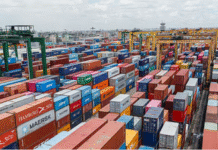

Cotton consumption in Bangladesh in marketing year (MY) 2022-23 will increase by 5.6 per cent year-on-year to 9.31 million bales.
This can be expected for a rise in demand for yarn and fabrics for corresponding placements of work orders from international clothing retailers and brands, according to United States Department of Agriculture (USDA).
The marketing year in cotton sales starts from August and ends in July.
Bangladesh has been receiving more work orders since the beginning of 2021 as many brands are shifting their orders from some of the competitor countries such as Vietnam and Indonesia, said the USDA.
Contacts also stated that Bangladesh is expecting more work orders in the coming months due to recent Covid-19 lockdowns in China, said the USDA.
The USDA data also put domestic raw cotton consumption in the MY 2021-22 at 9 million bales, which is 2.27 per cent higher than initial USDA official estimates. The USDA data forecasts that in the MY 2022-23 yarn and fabric consumption would reach 0.96 million tonnes and 6.4 billion metres respectively.
For the MY 2021-22, the data estimates yarn and fabric consumption to be 0.95 million tonnes and 6.3 billion metres respectively.
It forecasts that in the MY 2022-23 cotton imports would reach 8.9 million bales, up 7.2 per cent from the MY 2021-22 USDA official estimate, assuming increasing yarn and fabric demand by the garment industry.
The USDA estimates the MY 2021-22 cotton imports to be of 8.7 million bales, up 4.8 per cent over initial USDA official estimates. According to the National Board of Revenue data, Bangladesh has imported approximately 5 million bales of cotton in the first seven months of the MY 2021-22.
“We also believe that both the import and consumption of cotton will grow by nearly one million bales in the MY 2022-23,” said Monsoor Ahmed, chief executive officer of Bangladesh Textile Mills Association, the platform for the primary textile millers.
This is because the local spinners have already increased their spindle capacity while new investment in the primary textile sector came in even in the time of the Covid-19, Ahmed told The Daily Star over the phone.
Of the import destinations, India accounts for the largest market share.
In 2021, by quantity, Indian cotton made up 29 per cent of the imports, followed by Brazil (15 per cent), Benin (13 per cent), and the United States (9 per cent). The volume of US cotton exports to Bangladesh in 2021 was approximately 816,000 bales, 58 per cent lower than that in 2020.
Indian cotton is exported via Kolkata seaport and Benapole land port, with traders noting that transportation and logistics are cheaper as compared to other origins, with shorter shipment times due to geographic proximity.
The USDA forecasts that stocks at the end of the MY 2022-23 would be at 2.25 million bales, approximately 11 per cent lower than the MY 2021-22 USDA official estimate.
Due to global cotton supply chain issues and increased prices, local spinners will reduce their stock.
The USDA’s post said in the MY 2021-22 the remaining stock of cotton was estimated to be 2.51 million bales, similar to the USDA official estimate.
New orders for the Russian market contacts note that garment exporters in Bangladesh are uncertain about receiving payments from Russian buyers as Russian banks have been cut off from SWIFT.
They are also worried about shipments of existing orders to Russia, as shipping lines are suspending container bookings to the country.
According to the local news, the Bangladesh Garment Manufacturers and Exporters Association has asked exporters not to accept any new orders for the Russian market.
The textiles industry in Bangladesh is composed of yarn, fabric and dyeing-printing-finishing mills.
According to Bangladesh Textile Mills Association (BTMA), in calendar year (CY) 2021, the number of spinning mills reached 510 with an annual spindle capacity of 15 million bales, up 18 per cent and 7.1 per cent respectively from that the previous year.
However, Bangladesh is currently only consuming approximately 8.5 million bales of raw cotton annually.
Bangladesh’s yarn production recovered in 2021 following an extended period of market disruption due to Covid-19 induced lockdowns and restrictions in 2020.
The USDA post forecasts the MY 2022-23 yarn production at 760,000 tonnes, up 1.3 per cent compared to that in the MY 2021-22.
For the MY 2022-23, the USDA forecasts cotton harvest area at 46,000 hectares, up 2.2 per cent over the MY 2021-2022 USDA official estimate.
The post’s forecast for MY 2022-23 cotton production is 155,000 bales, up 2.6 per cent over the MY 2021-22 USDA official estimate, assuming favorable weather conditions and continuous government support.
Domestically produced cotton accounts for less than 2 per cent of total cotton consumption.
Total cotton cultivation in Bangladesh covers only 0.55 per cent of the country’s 8.1 million hectares of arable land. Bandarban, Jhenaidah, Jashore, and Rangamati are the major cotton producing areas of the country.









